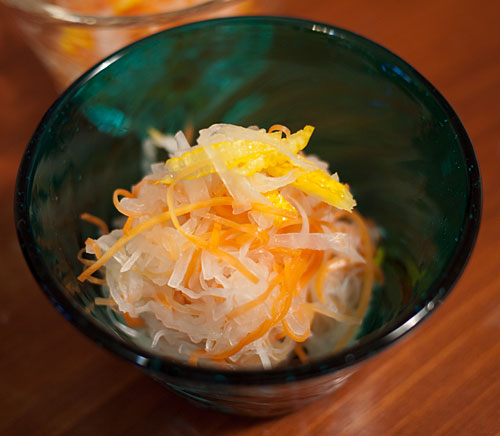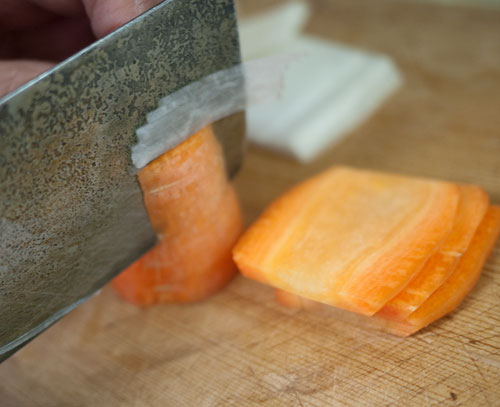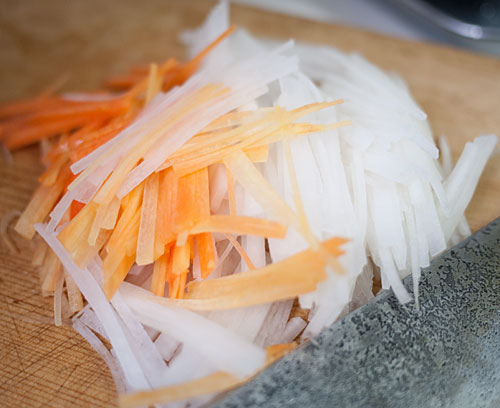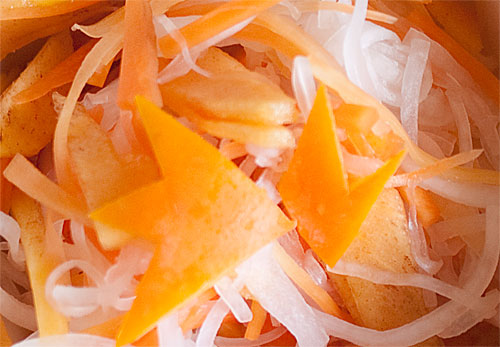Two-color namasu, a make-ahead daikon radish and carrot salad

Japan traditionally shuts down for at least 3 days from New Year's Day on. These days that's not exactly true, since many stores and such are open even on the 1st, but most people do take the 3 days off. The classic feast that is served during these 3 days is called osechi, and consists of a variety of dishes that are supposed to bring good luck and fortune in some way or another.
One of those dishes is namasu, a simple salad-type dish that is made with finely julienned daikon radish and carrot. The colors are very important, since the combination of white and red is used for festive occasions in Japan. Carrots are usually not exactly red (though there are some exotic varieties that are), but orange is close enough, so namasu signifies the wish for good luck and fortune for the new year.
All osechi dishes are designed to keep for a few days (to give the overworked housewife a break during the New Year holiday), even back in the days of no refrigeration. Namasu is no exception, though it is best kept in the refrigerator. This makes is a great side dish for bentos. Namasu actually improves over time, as the various flavors blend together. I actually don't like freshly made namasu that much - the daikon flavor is too pronounced, and the vinegar is too sharp - but after a minimum of a few hours in the fridge, it tastes great.
There are probably as many namasu recipes as there are homes in Japan, but this is my mother's version.
Recipe: Two-color namasu

Makes about 4 cups of namasu, enough to fill a large plastic container and last for a week or more.
- About 1 lb / 450g daikon radish (to yield 3 cups when cut)
- 1 large carrot or 2 small carrots (to yield 1 cup when cut)
- 1 tablespoon salt (sea salt is preferred)
- 1 to 2 tablespoons sugar
- 2 tablespoons rice vinegar
- 2 tablespoons yuzu or lemon juice
- Optional: a small piece of yuzu or lemon peel
Peel the daikon radish and carrot. (If you can get organic, untreated ones, peeling is not needed. Just give them a good scrub with a vegetable brush.) Cut them both into 2 inch / 5 cm long pieces.
You now need to cut them into fine julienne. A tip here: For optimal crunchiness, cut the vegetables with the grain, or in the direction the fibers run. Here you see the carrot being sliced. The fibers run up and down the length of the root (same with the daikon), and you want to julienne in that direction, not across the grain.

Here's a pile of finely cut daikon and carrots. (Note: you can use the julienne blade of a food processor, mandoline or vegetable slicer like the Benriner Slicer if you prefer.)

If you're using the yuzu or lemon peel, julienne it very finely and set aside.
Sprinkle the cut up vegetables with salt in a bowl, and massage the vegetables with your hands gently. A lot of water will come out, especially from the daikon. Squeeze this out firmly, taking handfuls at at time. Put the squeezed out vegetables in another bowl.
Add the vinegar, yuzu or lemon juice, and sugar to the bowl and mix together thoroughly. (Start with the lesser amount of sugar, and add more if you think it needs it.) Add the peel and mix again. Let this rest, well covered, in a refrigerator for at least several hours or overnight. It keeps in the refrigerator for at least a week if not more. To serve, take some out with chopsticks, draining off the excess liquid, and put into your serving container.
Variation: Two-color namasu with fresh or dried kaki (persimmon) or other dried fruit
This can be made either with the firm, slightly crunchy type of persimmon (the most common variety available in the US is Fuyu) or with hoshigaki, or dried persimmon. Since the persimmon is sweet, you can reduce or cut down on the sugar.
If using a firm, fresh persimmon, peel it and cut it into fine julienne as with the carrot and daikon radish. Mix it in with the salted and squeezed out vegetables. You will not need more than a tablespoon of sugar.
If using hoshigaki or dried persimmon, take off the blossom end and chop it up as finely as you can. Mix the chopped up persimmon with the with the salted and squeezed out vegetables. You may not need any sugar if you use dried persimmon, or just a little bit.
You can try other dried fruit too. Dried apricots are very interesting. I wasn't sure about dates, but you can give them a try. Dried figs may work too. Just chop them up finely and add as much as you like to the namasu.
Here's some kaki namasu, decorated on top with some cut-outs from the skin.

If you enjoyed this article, please consider supporting this site by becoming my patron via Patreon.
